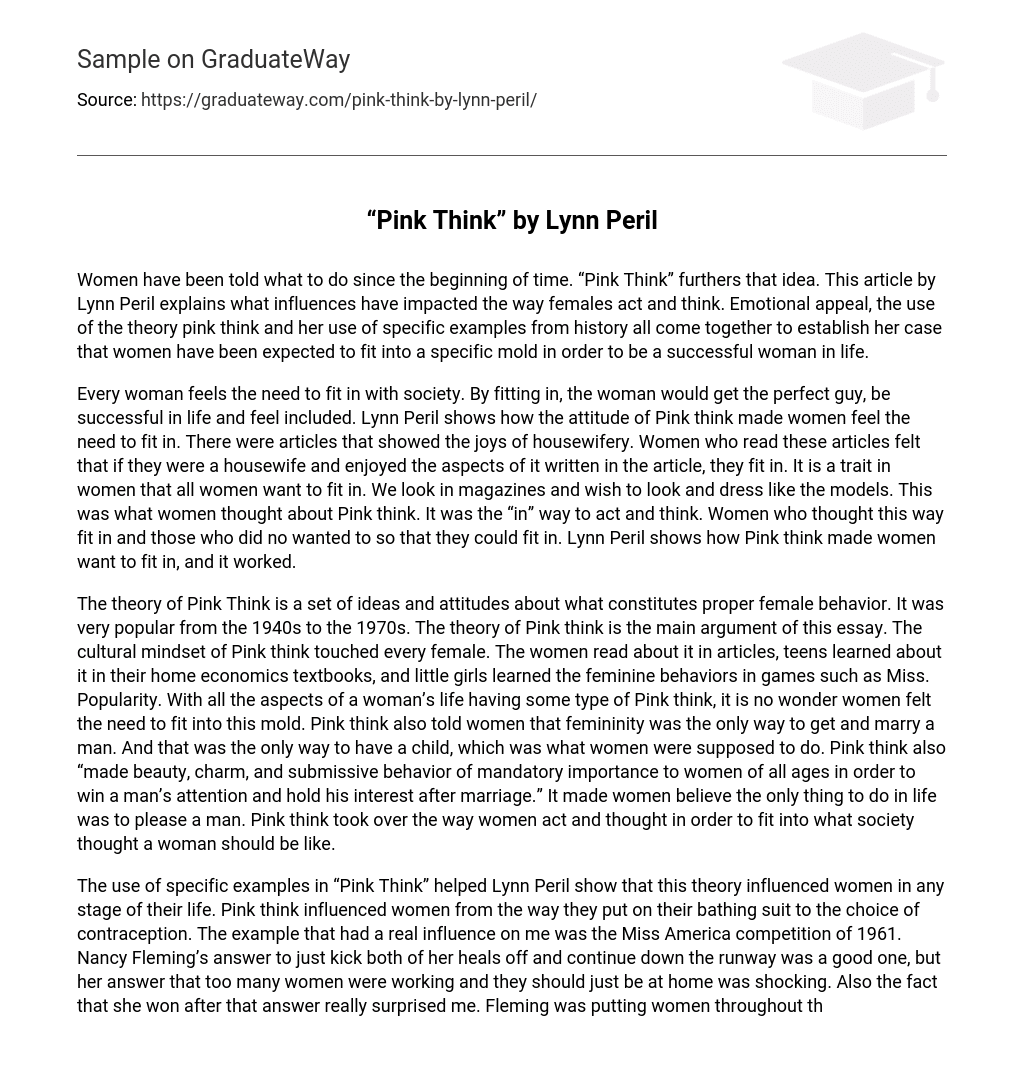The article by Lynn Peril, titled “Pink Think”, illustrates how women have been constantly instructed on how to behave throughout history. Peril explores various influences that have shaped female behavior and mindset, utilizing emotional appeal and referring to the concept of “pink think”. Alongside specific examples from historical context, she effectively argues that women have long been pressured to conform to certain expectations in order to achieve success in their lives.
According to Lynn Peril, all women desire to conform to societal norms in order to attract a desirable partner, achieve success, and feel included. The concept of Pink think greatly influenced women’s inclination to fit in. Articles promoting the joys of being a housewife played a significant role in shaping women’s perception of fitting in. They believed that embracing the characteristics of a housewife, as portrayed in these articles, was the key to fitting in. Women have a natural desire to emulate the appearances and styles of models showcased in magazines. This exemplifies how Pink think influenced women’s desire to conform. Acting and thinking in accordance with Pink think was seen as trendy and women who did not adhere to it felt the pressure of trying to fit in. Lynn Peril demonstrates how Pink think successfully cultivated women’s longing for acceptance and conformity.
The essay discusses the theory of Pink Think, which was a widely accepted set of ideas and attitudes about proper female behavior. This theory was popular during the mid-20th century. It influenced every aspect of a woman’s life, from reading articles about it to learning about feminine behaviors in home economics textbooks and games. Pink Think emphasized that femininity was essential for attracting and marrying a man, as well as fulfilling a woman’s role of having children. It also enforced the belief that beauty, charm, and submissive behavior were crucial for gaining a man’s attention and maintaining his interest in marriage. Consequently, women internalized these expectations in order to fit into society’s mold of a woman’s ideal characteristics and behaviors.
Lynn Peril used specific illustrations in “Pink Think” to demonstrate the impact of this theory on women at any stage of their lives. Pink think influenced various aspects of women’s lives, from their choice of swimsuits to their selection of contraception. One example that stood out to me was the 1961 Miss America competition. Nancy Fleming’s surprising and shocking response to the question suggested that women should quit working and stay at home. It was astonishing that she won despite her demeaning remarks towards women nationwide. Fleming’s stance belittled women by implying they should only be homemakers and have no place in the workforce. Women deserve the freedom to choose between work and staying at home. The symbol of America should not convey a message that women are superior to men and belong solely in households. By incorporating multiple specific examples, Lynn Peril effectively reaches a wider audience with her message.
Lynn Peril effectively utilizes emotional appeal, Pink think, and various specific examples to illustrate the influence on women’s behavior and thoughts. These influences persist even today, beyond the period when Pink think was prevalent (1940-1970). The expectations for women to conform to a particular mindset and behavior continue to exist. While Peril highlights the changing societal expectations for women’s behavior over time, she also acknowledges that certain ideas from the past still persist in modern society.





